The 64DREAM – December 1997 Interview: Shigesato Itoi and Shigeru Miyamoto Discuss the Nintendo 64DD
This issue celebrates the magazine’s one year anniversary with a discussion between two of the video game powerhouses at the time: Shigesato Itoi and Shigeru Miyamoto. They discuss their professional relationship, the unpopular Japanese TV advertisements for the Nintendo 64, the 64DD (two years before its release), and lots and lots of random personal questions!

First we dig up memories of ten years in the past. Itoi had always been a passionate fan of the Famicom, and was a real Famicom Evangelist; he bought five or six systems and passed them out to his friends! Miyamoto, on the other hand, confesses that he’d sat in on a few of Itoi’s lectures.
“This is Miyamoto, from Mario.” “Congratulations.”
Two conflicting memories of the eve of MOTHER’s birth
● Tell us about when you two first met.
● Itoi: It started when I’d gone to visit Nintendo. It was about ’86-’87? Someone in the advertising agency introduced me to Nintendo’s office since I was a fan of games, and I’d brought a project proposal for MOTHER with me.
● So it wasn’t an advertising job?
● Itoi: That was earlier on, when I’d gone with some advertising agency for a presentation.
● Miyamoto: Right. It was for an ad for the Mario series.
● Itoi: We proposed doing it all live-action.
● Miyamoto: I remember that. They said, “This is the Mario that children want to see.”
● Itoi: Well, it was nothing to write home about. (laughs) I can’t even remember the slogan.
● When you showed up with the MOTHER proposal, who first agreed to hear you out?
● Itoi: Mr. Imanishi [Head of Public Relations Board of Directors at time of article] and someone else, but I forgot who—someone in developing. And when I explained my project, they were like, “Oh, really, now? Wahahaha!” and I was like, “Yes, really! Wahahaha!” (laughs) But at one point they mentioned I was better off asking someone more familiar with developing, so they introduced me to Miyamoto. I think Miyamoto was wearing a company uniform at the time—yeah! Everyone was wearing uniforms! (laughs) A gray jacket like some kind of factory worker. There was something strange about it—suddenly meeting all these people in matching jackets.
● Miyamoto: It was less creepy when we were used to wearing it every day, but I suppose that’s how it’d seem from the outside. (laughs)
● Itoi: Well, not so much creepy as just feeling, wow, that’s the first time I’ve ever seen that. I went vacationing in China in 1980 and it was sort of the same thing. (laughs) Anyway, Miyamoto’s someone who always has and always will say flat-out what he’s thinking, so I was trying not to cry. (laughs)

Shigesato Itoi: Overseer of MOTHER series, namer of Nintendo 64, creator of Star Fox 64 ads, partner of good conversation with Miyamoto… at any rate, a man essential to the N64. 48 years old, blood type A.
● He criticized your MOTHER proposal?
● Itoi: It’s not that he criticized it. Looking back now, I know it wasn’t a big deal, but… I approached it like I was making an advertisement. With advertising, if something struck me and I felt from the start that it was gonna make it, then it’d make it. But Miyamoto wasn’t the least bit interested in it. He just sorta nodded and went, “Uh-huh, uh-huh,” like he wasn’t even listening. Questioned how I was gonna make it and stuff. (laughs)
● Miyamoto: Hey, I remember it. But we’d met before that. One day, without warning, some people from the advertising agency stopped by and you came with them into the development office.
● Itoi: Wha—really?
● Miyamoto: Yeah. I noticed you were there and was introduced as the man who made Super Mario. Then you said to me, “Congratulations.” When you said that, I realized for the first time that its success was a happy occasion, and was moved by what a nice greeting that was. (laughs) Then a few of the younger employees came and asked you for your autograph and later on they got hounded on by the boss for undermining the workplace. (laughs)
● Itoi: I don’t remember anything about autographs, but I remember, now, going in the development office. I was watching the monitors of employees drawing a character from Doki Doki Panic climbing a rock, and you explained that this is how games are made.
● Miyamoto: I did?
● Itoi: Looks like we remember totally different parts. I’m impressed with myself now for coming up with “Congratulations” as a greeting. (laughs)
● Miyamoto: I felt from the very beginning that I’d be willing to work on something with Itoi. But I mentioned that I wouldn’t appreciate it if I couldn’t get him to take it seriously. There’s no point in building a project around a couple of big names. The second time we met I brought some development materials and slammed the big pile down on the desk to show him how much writing it took. Told him to write up at least that much, as a way to threaten him. (laughs)
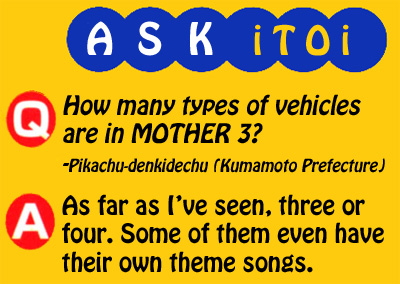
● So, Itoi, when your MOTHER proposal was criticized—
● Miyamoto: I wasn’t criticizing him! (laughs)
● Itoi: Boy, you jump to conclusions. (laughs)
● (laughs) Did you find him mean?
● Itoi: It’s not that. It was a sadness directed at myself, for how powerless I felt. Like I’d been underestimating the whole thing. That project proposal was absolutely nothing compared to the mountain of paperwork I faced if I ended up undertaking it. But the paperwork wasn’t the problem. I was fine with that part, I just thought it’d be really tough to make something that would genuinely impress people. I did a lot of thinking on the bullet train ride home, about how I should go about doing it. And after that, Nintendo was nice enough to look into what kind of team I could best work with.
● Miyamoto: And that’s when we had our first proper meeting together.
● Itoi: The team I met at Nintendo apparently thought I was only going to join a meeting once or twice and then be done with it. Like I was only filling some outside supervisory role. They thought they’d have to come up with everything themselves, until I got totally involved with it afterwards and they realized that wasn’t the case.

Shigeru Miyamoto: Overseer of Zelda 64, creator of Mario, guitar-loving father, partner of good conversation with Itoi… at any rate, a man essential to the N64. 44 going on 45 years old (born November 16th), probably blood type A.
After-school club hijinks and global strategy discussions
● Itoi: Things move fast when you get to know people in the creative business. It didn’t feel like we were gradually getting to know one another.
● What did you find charming about one another?
● Itoi: Charming? (bursts out laughing)
● People can respect the work of another person, but there’s still a tendency for two people to not mesh very well.
● Itoi: That’s possible, but y’know, if I respect someone’s work, even if we don’t mesh on a personal level I just bury that part and forget it. If there’s someone I absolutely can’t stand but he’s done work that I can respect, then yeah, he’s a great man.
● Miyamoto: Wonder which one I was. (laughs)
● Itoi: Between Miyamoto and I personally, I feel I’m sort of in a big-brother role. Miyamoto’s above me on a professional level, though.
● Miyamoto: Which is why I’m the one who comes here [Itoi’s office] for counseling. (laughs)

● Do you ever bring an in-progress game here to get advice from Itoi?
● Miyamoto: No, I don’t really do anything like that.
● Itoi: Miyamoto doesn’t come to me for advice on games. When we meet, it’s more like hijinks in a high school after-school club room. Once talks turn to work, I mess around and Miyamoto gets down to business.
● I hear you two also have a meeting planned today as soon as our interview is finished. What kind of things will you be discussing?
● Itoi: Big things.
● Miyamoto: Global strategies. (laughs)
● Itoi: In particular we talk about things that seem unrelated to the task at hand. Global-strategy things. (laughs) There’s a lot to talk about since today’s meeting is the first one in a while, so today I think I’ll have a heated discussion about world domination. (laughs) I talk around things I’m thinking about, and… sometimes I want to align my field of vision with Miyamoto’s. When I double-check where I’m at with my thoughts, and we meet up and get back on track, that makes the phone calls and mails afterward a lot smoother.

● Miyamoto, do you ever have Itoi check your texts and slogans?
● Miyamoto: Once in a while. (laughs) And the occasional advice on a title.
● Itoi: Miyamoto also understands the importance of words, and is aware of issues at Nintendo. He’s mentioned how there hasn’t been enough effort to raise that mindset among employees. So we have a lot of conversations about language.

“Nintendo commercials are so lame.”
It’s not that Sony is cool; Nintendo is just uncool.
● I think the N64 hasn’t caught on as well as we hoped despite how incredible it is because the console itself isn’t entirely understood. In particular, we’ve received messages from our readers talking about how the commercials don’t do a good job of getting its more amazing features across.
● Itoi: It’s not too late… It’s not hopeless, and I know what kind of changes we should make. It’s just that things are different nowadays. I know what it would take to address the new environment, though, so I think things will turn out fine either way.
● What do you mean by “either way?”
● Itoi: I’m sure people will understand once the games emerge from under the surface of the water, where they’re hiding. I hope so, anyway. We’ve got the seeds planted, but I want to plant even more of them.

● What about you, Miyamoto?
● Miyamoto: There’s a flow, a momentum to it, so… I think all we can do is chip away at it. I have no intention of throwing things around. But you can’t release a product after missing the window of opportunity to release it, so I’d rather be proactive. But–not to bring up the true-false statement [see quiz part two below], but–since I can’t see games going away in my lifetime, I’m in no hurry with anything except PR campaigns. Getting people to know our work might just mean trying to hurry and finish the games people are looking forward to like Zelda 64 and Yoshi. Even if I take a really active stance in what I say, the more I talk, the more I’m just running in place… Either way, all we can do is keep working. We were supposed to have the usual games all lined up by last summer, but we’re still running late, so I’ll pipe down and focus on working on them.
● A lot of readers think the Playstation commercials are really cool. Itoi, what do you think of the ads as a professional advertiser?
● Itoi: I can see there being people who find it cool. But it’s probably more accurate to just call Nintendo’s uncool, rather than say Sony’s ads are cool.
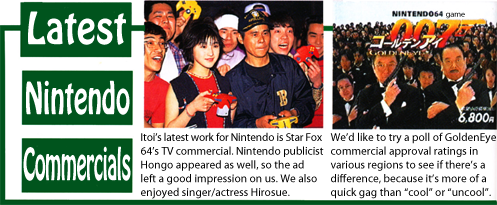
● Nintendo’s commercials are uncool?
● Itoi: They are. There’s a ton of reasoning behind them, but… they just kinda end up uncool.
● Miyamoto: It’s not that each individual commercial turned out uncool. It’s uncool that they’re being seen as uncool.
● Itoi: In order for Nintendo’s ads to improve, all the other commercials are going to have to improve, too. We’re on the topic of Nintendo and Sony ads right now, but there are plenty of other ads out there, right? Aren’t they all boring? Nintendo’s just another part of that. We’ve got to consider advertising a whole.
● Miyamoto: Also, I’m not really in a position to say this while being called uncool, but not many people out there think anything else besides just, “Nintendo is uncool, Sony is cool.” I’ve thought for the past few years about how games as a whole will deteriorate if people aren’t thinking beyond that. I don’t think it’s enough to simply have a good director, make a good game, and make a good ad.
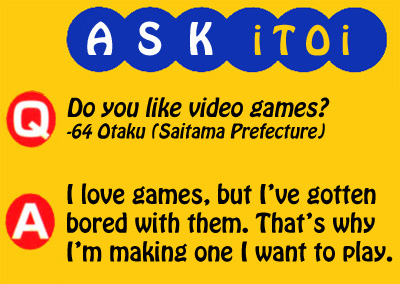
● Miyamoto, do you win anything, too, in competitions at advertising companies?
● Miyamoto: Not really. Advertisement creators have strong emotional attachments to their work, so I know better than to butt in. Ads are more of an objective thing. I’ll say something once in a while, but… is that bad?
● Itoi: I’ve started feeling like I want others to speak up more, so maybe you should. You’re not an advertising pro, so you might be worried about having different thoughts and doubts on different days. But we might be reaching a period when I’d rather have you speak up to a certain extent.
![]()
 ● Miyamoto: What I find amazing about Itoi? Hmm, maybe his perspective. People see things all kinds of ways—short-sighted, far-sighted, broad-minded and narrow-minded. Itoi just sees things really clearly. Another thing is the quality he maintains even with his speed. I use him as an example to my staff and tell them how a pro stays up all night to write this much (pantomimes thick stack of papers).
● Miyamoto: What I find amazing about Itoi? Hmm, maybe his perspective. People see things all kinds of ways—short-sighted, far-sighted, broad-minded and narrow-minded. Itoi just sees things really clearly. Another thing is the quality he maintains even with his speed. I use him as an example to my staff and tell them how a pro stays up all night to write this much (pantomimes thick stack of papers).
● Itoi: I think his “sense of sports” is amazing–how he turns “things” into “actions.” It’s a skill no one’s ever had before. Not sportsmen, not engineers, not painters. It was only created through game development, just like there would be no need for kicking skills without soccer. I feel like, for the first time, there are people who think about objects or expressions in terms of their motion. For example, Miyamoto’s action of stirring sugar into his coffee is nothing amazing, but when it comes to creating that action in a game, he creates the action of sugar-stirring with an entirely different approach than an animator would.
● Miyamoto: I’m aware of it. I can’t put things into words like Itoi can, though. I’ve said this before, but there aren’t a lot of people in the world who can explain what they’re doing. I feel jealous of Itoi when I’m talking with him and I hear him arrange his words in a way that allows him to think about them. I don’t have the capacity to arrange my words so neatly. Even when I’m making games, whether or not I’ve prepared a space to arrange my thoughts makes a huge difference when moving on to the next step. I come here [Itoi’s office] for help in arranging my thoughts.
![]()
● Itoi, you worked on Star Fox 64 ads, right?
● Itoi: Yeah. I also recently made them for my bass-fishing game. Long ago I worked on the ones for MOTHER 2 and Gameboy Bros. [Series of colored Game Boys, “Play It Loud” in America.]
● Are you making the ads for MOTHER 3 on your own?
● Itoi: I might do them myself. MOTHER 1 is the only game I passed to someone else to work on. According to commercial approval ratings, the commercials for MOTHER 2 remain at the top of the list to this day.
● Do you have any ideas yet?
● Itoi: Nothing.
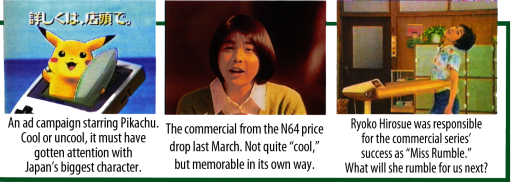
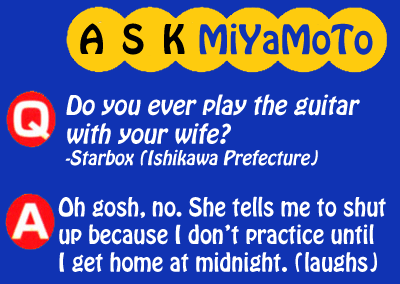
● If we were to pinpoint something that the N64 is missing now, what would you say that is?
● Miyamoto: I think it’d be a bad move for us to drive up the number of titles we release ourselves. I think having twenty titles out and available to play at any time is enough–it’s not that I’m elitist, it’s just my own opinion as a consumer. It’s just that the N64 is lacking variety in its genre of games. Like even though there are so few titles, there are several soccer games.
● Itoi: The same could be said for other consoles. There are lots of titles, but not a whole lot of variety, so everyone screws up that balance.
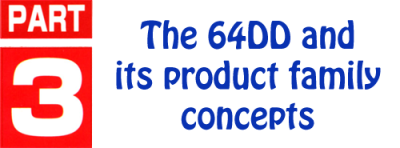
The N64 has yet to fully reveal itself to us. The console is standing at the starting line now that the 64DD and its conceptual products have been unveiled. We’ll know everything come November at the enormous event in the Makuhari Messe convention center.
The 64DD Raises the Bar for Game-Playing Potential
Almost all new plans for the N64 involve the 64DD.
● Although the N64 has reached its true form with the release of the 64DD, consumers know very little about the system. We get a lot of questions asking, “Just what is the 64DD?”
● Miyamoto: We haven’t really been sure to what extent we need to explain it to magazines. The 64DD was originally meant as an alternative to CD-ROM. When it comes to the future of gaming media, Nintendo will continue to make cartridges, but we concluded that DD was a better option than CD for expanding the range of gameplay. It would have been easier to understand if the DD was already included when the N64 first came out. It’s getting harder to explain after the fact. (laughs) Here’s the difference between each media: CD holds a lot of data, DD holds a moderate amount of data and backs the data up, and ROMs hold the least data and process the fastest. By attaching a DD to the game console, we can drastically increase the number of possible genres. Distributing hardware that can make these new genres is a benefit of the long life of this industry. The market’s only going to shrink if there’s nothing but price drops and scale expansions for preexisting genres.
● Itoi: I came up with a lot of ideas because of the 64DD. All things start with the 64DD. There are so many ideas I wouldn’t have been allowed to come up with if we didn’t have the 64DD. Including the game Cabbage.
● Miyamoto: Almost every new project for the N64 is based on the 64DD. But there are basic technologies required to make things on the 64DD, so I think we’ll make the game on a cartridge first, then add the technology we’ve cultivated to finish it up as a full-out 64DD game.
● What do you have in mind for price?
● Miyamoto: I’m not under the assumption that we can charge as much as we want if it’s interesting enough, but we can’t let this turn into a mere price war, either. There are plenty of markets out there that collapsed after waging price wars, so I’m nervous about the video game industry dying out for a reason like that.
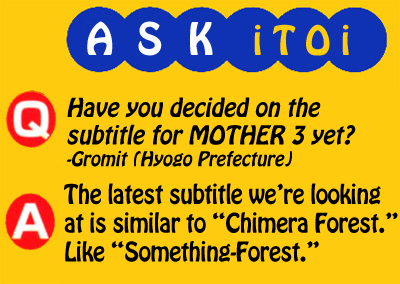
64DD and Product-Line Design Will Change Gameplay Structure
● Itoi, do you ever get hassled about product-line design?
● Itoi: What’s product-line design?
● We’re often asked that by readers, too.
● Itoi: What is it?
● Miyamoto: Not a game that only works on a single cartridge, but a disc of game data that can be used as-is across several games.
● Itoi: Oh, I get it.
● Miyamoto: It means that several games have a common link between them. It’s not confined to one package–they’re each related, so… we mentioned Pokemon, didn’t we?
● Itoi: Yeah, I get it now.
● Miyamoto: So you can play the Pokemon gameboy cartridge on the 64DD. We’re considering adapting for not just Pokemon Gold and Silver, but all of the versions, and allowing players to perform “tune-ups” on games through the 64DD and change the structure of gameplay. For example, when people buy Macintosh computers, they all start out identical. But as time goes on, each person’s Mac becomes a different computer. So you add on different data and can create your own unique games. We’re considering setting one package at 6000 yen and making it like a collectible set of baseball cards–players can pick and choose what they like to build their own original kit out of a compilation of different sets of parts. Writing your own data like that is what makes media like the DD so convenient.

● How does that work, exactly?
● Miyamoto: F-Zero 64 will first come out on a cartridge. When everyone’s played through that, we release an expansion kit as 64DD software at a relatively low cost. It’ll include new courses, new cars, and a course editor so friends can exchange and play one another’s tracks. If the network environment is just right, we could for example have The 64DREAM magazine recruit best lap times from all over the country, take the top ten and distribute ghost racers to players. It would transform not only gaming magazines, but also the gaming market with fees for downloadable content. We’d also have to situate things so the current distribution system doesn’t take a huge hit.
● The 64DD doesn’t come with communication functions, does it?
● Miyamoto: No, but the 64DD has a structure in place for low-cost communication.

● Is MOTHER 3 separate from this product-line design?
● Itoi: I’m not considering it. Maybe Iwata has something in mind. I’m still going along at the level I started at, which isn’t one that would cross platforms. …But if there’s something that could host a concept like that for us, we have all kinds of ideas that might have some potential.
● Miyamoto: It does have a structure that would allow importing Mario Artist drawings into MOTHER 3, though.
● Itoi: If it’s only to that degree, then I wouldn’t really be interested in it. It’s not interesting to show off what’s possible just for the sake of it, so I want something that’s a little more necessary. And I don’t have anything in mind right now. Look at how everyone rotated and resized graphics when it became possible to rotate and resize. I really hate that. (laughs)
● Miyamoto: It’s true that I want to make the 64DD into some kind of strange toy, and broaden the playing field so people aren’t using everything up as they all make the same things.

“Greedy users spur changes in games.”
● Could you offer some final words to all those N64 users out there?
● Itoi: It’s boring to just call an interesting game “interesting.” I think it’s the greedy users and not the complainers that are going to spur growth when they think about what was interesting about a game and what they want done. After a while the creator and the distributor are going to combine into a single role. From that end, everything’s going to get dull if you’re only approaching things passively–when everyone gets together to play, it’s easy to sit out, but the ones calling everyone to play are the ones that survive.
● Miyamoto: Anyway, I haven’t made the first part of the things that I need to make, so…
● Itoi: The topic always turns to that. (laughs)
● Miyamoto: (laughs) You’ve got to look at that before you start getting excited about what comes next. But talking about hardware is irrelevant, and it’s too early to talk about five, ten years in the future. Please play with an open mind—don’t focus on being on the N64 team. Who knows if I’ll ever make a Playstation game. (laughs) But as I’ve been saying, the N64 hardware is designed to accommodate the will of creators, so it has a future. I think the next generation for other hardware is going to be biased towards the N64.

![]() What’s the reason for changing MOTHER 3’s graphic and music team from the previous series?
What’s the reason for changing MOTHER 3’s graphic and music team from the previous series?
![]() Because the graphics changed to 3D polygons.
Because the graphics changed to 3D polygons.
When it came to the graphics, I knew I had to come up with a new team since the game was now in 3D. As far as the music, the new music guy that had just joined the company was really good, so more than anything it was a decision to take a chance with him. He wasn’t a so-called celebrity, and I didn’t want the music director bothered by accusations of merely having connections with me in the past, but he’s Sakai, who’s done the music of a certain RPG in the past. He’s seriously good. I really hit the jackpot. (laughs) Sakai reads the scenario’s I’ve written and always manages to build upon the image I was going for. It’s thanks to the music that these scenarios get filled out, so as the scenario writer, I couldn’t be happier.

The main entrance to the HAL Laboratory Development Center in Yamanashi. We found out that MOTHER 3’s music director Sakai is an employee of HAL!
![]() Do you have a favorite character within MOTHER 3?
Do you have a favorite character within MOTHER 3?
![]() I have a tendency to fall for the supporting side characters. (laughs)
I have a tendency to fall for the supporting side characters. (laughs)
I usually pick one after the characters have already come to life. Story-wise, probably the Drago. There’s a Drago that looks kind of like a dragon, and I felt really strongly about it when I was writing the scenario. I could just feel the pangs of emotion.
.
![]() Is there a concept behind the logo?
Is there a concept behind the logo?
![]() There’s definitely a certain concept there.
There’s definitely a certain concept there.
Nowadays, exclusion is such a big thing. I think it’s fine if a Nintendo 64 fan plays a Playstation—I don’t like when things of the same color all clump together in the same place. I wanted to turn this into a general theme, so the logo has one pure object with another object mixed in. Usually this makes people uncomfortable, but it’s that aspect in which our future lies.
.
![]() Will Takuya Kimura be in the commercial for MOTHER 3?
Will Takuya Kimura be in the commercial for MOTHER 3?
![]() It seems he’s up for it. (laughs)
It seems he’s up for it. (laughs)
But his appearance fee sure has shot up since then. (laughs) It sounds like he’s assuming it’s a given that he’ll be in it, though. I wonder what the young boy from the MOTHER 2 commercial is doing nowadays. He must be so tall by now.

We suggested Itoi have the MOTHER 3 commercial say “Years later…” and feature Takuya Kimura and the boy from the MOTHER 2 commercial. Itoi replied, “Well, that’s one idea.” (laughs)
![]() Is the ending decided yet?
Is the ending decided yet?
![]() No, not yet.
No, not yet.
It’s the same when I write slogans; when I come up with something, I always stick a pin in it and mull over whether it’s good enough or not. Then, if I feel good about it one day, and still feel good about it the next day, and that continues on, whatever holds up through that process is what I put together. Since I could still come up with something even more impressive, I figured it’s better to keep it to myself for now. I don’t think I’m going to start bringing the ending to light until we’ve reached a point of completion with everything else. But if you were to ask if the ending makes you cry, well, I think you’ll be crying halfway through. The end might make you freeze and go, “…What?!” Really, it’s a cruel game. (laughs)

MOTHER 1 for the Famicom featured the slogan, “No crying until the end.” It’s a rare game that’s hard to come across even in Akihabara.
![]() How about the official title for Cabbage?
How about the official title for Cabbage?
![]() It’s not decided yet.
It’s not decided yet.
But the title Cabbage is strangely popular. (laughs) It’s just something I randomly blurted out, though. Either way, being asked about the title makes me want to just stick with Cabbage. (laughs) Maybe there was some subconscious connection with Cabbage Patch Kids. At this point I think Cabbage would be just fine. It’s not that there aren’t other names on the board, though.

![]() How is Cabbage coming along?
How is Cabbage coming along?
![]() We can finally see it all coming together.
We can finally see it all coming together.
Now that Iwata from HAL Laboratory has joined us, the tools we’re using to make Cabbage are drastically modernizing. Making those tools is the most laborious part. So it looks like that part’s finishing up, and then there’s a team that’s solidifying the specifications. So right now we’re in the middle of docking the two together. So it’s all moving forward. I’d like to be very vivid when debuting the characters, so please wait a little longer. We aren’t planning on showing it at the exhibition in November. After all, we’re flying this game under the radar of the Nintendo president. That’s what’s fun about it. Its debut might not be until early next year.
![]() Is Itoriki Curry really the best stuff in the world?
Is Itoriki Curry really the best stuff in the world?
![]() You bet!! It’s delicious! [t/n: See information here.]
You bet!! It’s delicious! [t/n: See information here.]
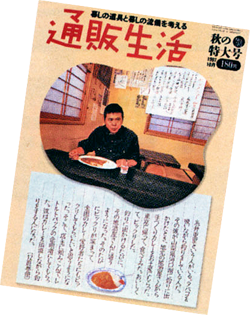
Itoi is on the cover of this issue of Tsuhan Seikatsu (Mail-Order Life.) He came across this “world’s best curry” while fishing at Kawaguchi Lake in Yamanashi Prefecture.
Just yesterday I got a fax from Akiko Yano and her husband [Ryuichi Sakamoto] in New York. Both they and Sister M [their daughter] said it was delicious. It’s a reproduction of curry being made at a liquor store called Itoriki. We’re having a factory produce it for us, and we’re selling it through mail-order. One package is about 500 yen, I think. I pour myself into making a good bowl of curry about once a year, but it’s more delicious than anything I could hope to make.
![]() Are you going to continue to work on more games in the future?
Are you going to continue to work on more games in the future?
![]() I plan on doing plenty more games.
I plan on doing plenty more games.
I think concepts are crucial for games, so aside from Cabbage I want to explore even more. With the bass fishing game, I was worried about body movements and was trying to figure out how to make the actions behind the fishing more realistic. Iwata is doing the basic research at HAL Laboratory, so once that’s done we’ll move forward for an N64 version. Plus, the major features of the 64DD are complete, so after we’re done, I’ve got plenty of ideas prepared for our meeting so Miyamoto can keep saying, “No, I don’t think so.” (laughs)

This picture of “Flying Itoi” is hung up on the wall at the Tokyo Shigesato Itoi Office. Between all that fishing and flying, Itoi sure is a busy guy. Please take care not to get hurt.
.
![]() Tell us about the camera controls in Zelda 64.
Tell us about the camera controls in Zelda 64.
![]() Please wait one more month.
Please wait one more month.
You can switch between normal view and first-person mode by using the top of the C button unit. There are all kinds of convenient camera modes. The player will be moving the camera around relatively often, but the controls are simple. Please wait one more month to see the details about the system and things like the black border from the widescreen view.

There’s even a lot of meaning behind the black border. (laughs)
![]() What are the items like in Zelda 64?
What are the items like in Zelda 64?
![]() The boomerang is great in 3D.
The boomerang is great in 3D.
We’ve retained a lot of the items that have always been around, including the hookshot. But we’re not depending on the 3D transition to do all the work in making the items great. My favorite 3D item is the boomerang. It comes back to you after you throw it, and if you miss the catch upon its return, you grunt as it smacks you. It makes me pretty happy. (laughs)

The boomerang that’s always been used safely. Hmm, it does seem difficult to catch it in 3D…
![]() Is “time” the theme of Zelda 64?
Is “time” the theme of Zelda 64?
![]() The flow of time is a fundamental system of the game.
The flow of time is a fundamental system of the game.
This time you can become Young Link, so time is a fundamental element. Time flows naturally in the game, but as you know, scenery changes throughout the day. Sunlight, light colors–it’s all there, so get excited.

Even hot deserts are supposed to get pretty chilly at night. (I’ve never been.) Maybe we can feel the temperature drop in the game.
![]() Do you feel an attachment to Luigi, too?
Do you feel an attachment to Luigi, too?
![]() I certainly do. (laughs) He’s in Mario 64-2, too.
I certainly do. (laughs) He’s in Mario 64-2, too.
We’re in the middle of preparing Mario 64-2 for release on the 64DD. I’d like to take advantage of the 64DD’s ability to store information. As of now, Luigi’s also a full part of the game, but we haven’t started thinking about 2-player gameplay with Mario and Luigi yet. We’ll tackle that once we’ve got the system ironed out—we’ve figured out the processing power issues, so we could do it if we tried. How many Luigi fans do you suppose there are? (Editing department replies: “Quite a lot.”) If Luigi’s really that popular, maybe I’ll made a green box for Mario 64-2. (laughs)
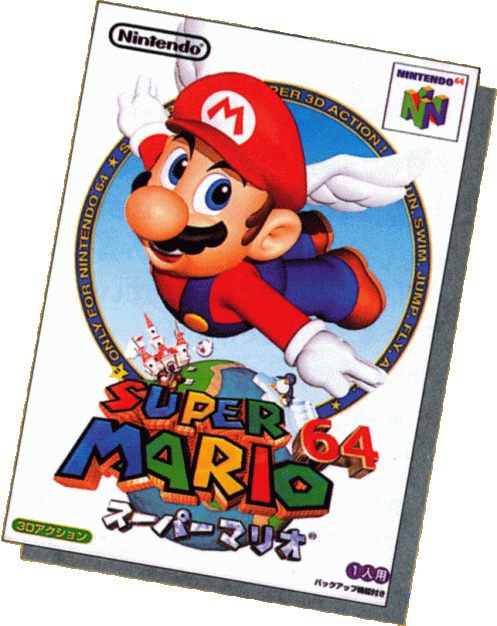
The prequel had a white box. Maybe we’ll see a red box for Mario and a green box for Luigi…and a limited edition peach box for Peach? That’d be amazing. You’ve got to, Miyamoto. Now for Luigi fans to take responsibility and buy the green boxes. (laughs)
![]() What was the happiest moment of your life?
What was the happiest moment of your life?
![]() Maybe getting into college.
Maybe getting into college.
But I’d say that it made me feel the best, not that it made me happy. The first time I took my university entrance exams, I failed. At the time, I looked at the line of sakura trees at Kenrokuen (one of the Three Great Gardens of Japan in Kanazawa City; Miyamoyo’s alma mater is Kanazawa College of Art), and imagined how different it could be if I could walk along that path with a feeling of liberation. When I passed my exams the next year and walked it, it did end up feeling great. (laughs) (We didn’t end up asking Miyamoto how it felt to be a ronin.)
![]() What is the most important thing to you?
What is the most important thing to you?
![]() Relationships with others.
Relationships with others.
It’s been more-so lately as our projects get larger and our staff continues to grow. Our Analysis and Development division now has over a hundred staff members, so it’s more than just simple personal relationships at this point—it’s barely possible to line up all the faces with the names. We must care for our ties between each other, because in the end, a game is something created by people. It’s not just a matter of tossing a group together, and you can’t just approach it as having someone make something.

We get this question a lot, but it’s not that every single person in Nintendo is directly involved with game development. There are countless unsung heroes doing their best behind the scenes. (Photograph features Hongo and the Mario 64 staff from the Analysis and Development division.)
![]() What do you do on your days off?
What do you do on your days off?
![]() Lately I’ve been swimming.
Lately I’ve been swimming.
When I’m swimming, all I can think about is how tired I am. And that’s a good thing, to clear my mind like that. There’s no way I could possibly think about Mario’s underwater movements when I’m swimming. (laughs) If I started thinking about it, I’d start choking on pool water. And once I started swimming, I stopped going to pachinko. Pachinko cleared my mind, too. Then there’s guitar practice. But if I practice guitar on my days off, my kid yells at me for interrupting piano practice. (laughs) Even though I try to play guitar as a back-up to the piano… (laughs)
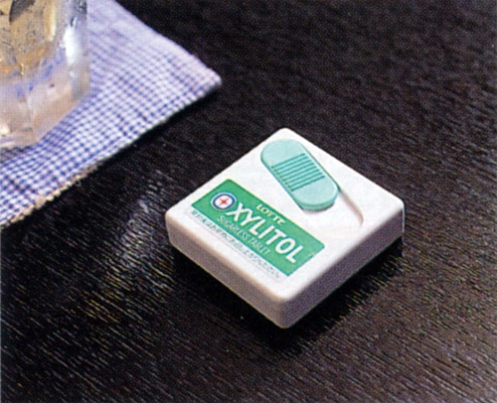
Miyamoto’s latest favorite anti-cavity mint gum. According to Itoi, “If you swallow too many, it’ll give you the runs. But that’s interesting in its own right. (laughs)”
 .
.
Trackbacks & Pingbacks
- Translated 1997 Interview with Miyamoto and Itoi Reveals Nintendo 64 Insights
- 1997 Interview with Miyamoto and Itoi Covers Original Plans for the 64DD | N64 Blog
- Miyamoto e Itoi parlando di N64DD divagando un po' - Il Forum ufficiale di Multiplayer.it, con discussioni, sondaggi e le ultime informazioni
- Wii U: The N64 Reborn - Blog by Cartoonami - IGN
- N64th Street -
- Mother 3 - Is An Official English Translation Finally Coming For The EarthBound Sequel? - Rumor - N Video Games
- A história do Nintendo 64 - Memória BIT
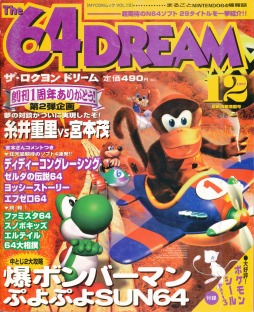



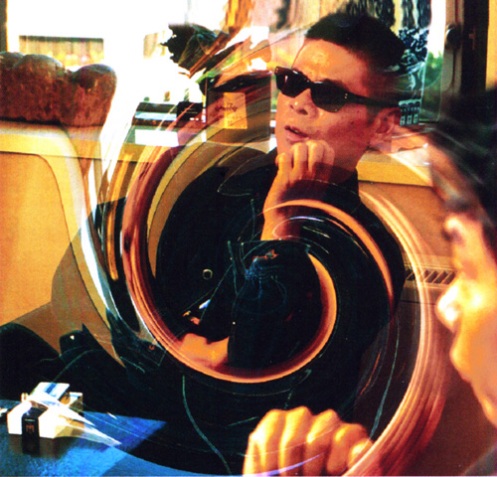



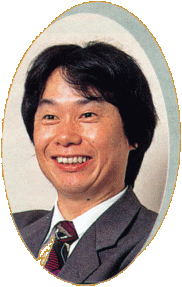

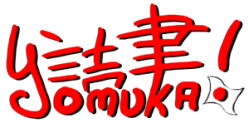
This is probably the most insightful Itoi x Miyamoto interview I’ve ever read. Thanks for the translation, Chewy!
Glad you enjoyed it! Seemed less Earthboundy than my usual finds, heh.
This was a great read. There are so many great nuggets of information I never knew about. Thank you so much for the translation! And OH! Look at that April issue cover! 😮 And there are TWO D.C.M.C. shirt variations!? I wonder where these prizes ended up.
Yeah, my first thought was wondering what happened to all those prizes.
16 years ago… This is the first time I see Iwata mentioned… little did they know he would end up and president of nintendo.
This was N64 time… now it’s:
Time for WiiU.
Two business men talking business. I like this translation a lot. It shows a more mature side to these guys that what we usually see in the West.
Those carts are pretty sweet. Some lucky fuck is probably sitting on a goldmine.
i never comment on blogs, but its merely intersting this interview. it make fell a good feelings, and make me see at itoi and miyamoto like a real genius people.
Thanks for this article! ❤